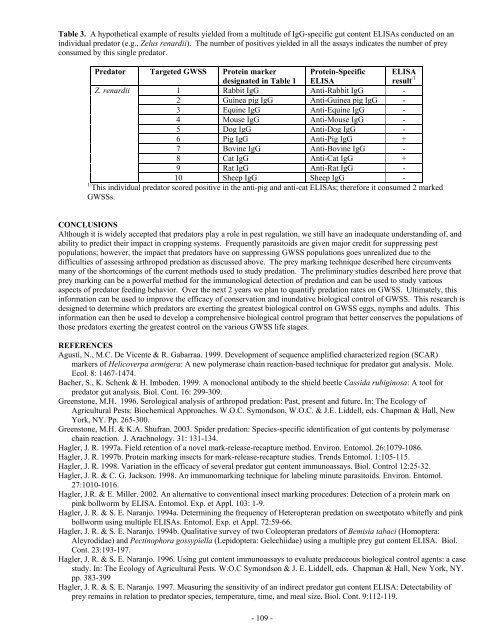Impact Of Host Plant Xylem Fluid On Xylella Fastidiosa Multiplication ...
Impact Of Host Plant Xylem Fluid On Xylella Fastidiosa Multiplication ...
Impact Of Host Plant Xylem Fluid On Xylella Fastidiosa Multiplication ...
You also want an ePaper? Increase the reach of your titles
YUMPU automatically turns print PDFs into web optimized ePapers that Google loves.
Table 3. A hypothetical example of results yielded from a multitude of IgG-specific gut content ELISAs conducted on an<br />
individual predator (e.g., Zelus renardii). The number of positives yielded in all the assays indicates the number of prey<br />
consumed by this single predator.<br />
Protein-Specific<br />
ELISA<br />
1 Rabbit IgG Anti-Rabbit IgG -<br />
2 Guinea pig IgG Anti-Guinea pig IgG -<br />
3 Equine IgG Anti-Equine IgG -<br />
4 Mouse IgG Anti-Mouse IgG -<br />
5 Dog IgG Anti-Dog IgG -<br />
6 Pig IgG Anti-Pig IgG +<br />
7 Bovine IgG Anti-Bovine IgG -<br />
8 Cat IgG Anti-Cat IgG +<br />
9 Rat IgG Anti-Rat IgG -<br />
Predator Targeted GWSS Protein marker<br />
designated in Table 1<br />
Z. renardii<br />
ELISA<br />
result /1<br />
10 Sheep IgG Sheep IgG -<br />
1/ This individual predator scored positive in the anti-pig and anti-cat ELISAs; therefore it consumed 2 marked<br />
GWSSs.<br />
CONCLUSIONS<br />
Although it is widely accepted that predators play a role in pest regulation, we still have an inadequate understanding of, and<br />
ability to predict their impact in cropping systems. Frequently parasitoids are given major credit for suppressing pest<br />
populations; however, the impact that predators have on suppressing GWSS populations goes unrealized due to the<br />
difficulties of assessing arthropod predation as discussed above. The prey marking technique described here circumvents<br />
many of the shortcomings of the current methods used to study predation. The preliminary studies described here prove that<br />
prey marking can be a powerful method for the immunological detection of predation and can be used to study various<br />
aspects of predator feeding behavior. Over the next 2 years we plan to quantify predation rates on GWSS. Ultimately, this<br />
information can be used to improve the efficacy of conservation and inundative biological control of GWSS. This research is<br />
designed to determine which predators are exerting the greatest biological control on GWSS eggs, nymphs and adults. This<br />
information can then be used to develop a comprehensive biological control program that better conserves the populations of<br />
those predators exerting the greatest control on the various GWSS life stages.<br />
REFERENCES<br />
Agustí, N., M.C. De Vicente & R. Gabarraa. 1999. Development of sequence amplified characterized region (SCAR)<br />
markers of Helicoverpa armigera: A new polymerase chain reaction-based technique for predator gut analysis. Mole.<br />
Ecol. 8: 1467-1474.<br />
Bacher, S., K. Schenk & H. Imboden. 1999. A monoclonal antibody to the shield beetle Cassida rubiginosa: A tool for<br />
predator gut analysis. Biol. Cont. 16: 299-309.<br />
Greenstone, M.H. 1996. Serological analysis of arthropod predation: Past, present and future. In: The Ecology of<br />
Agricultural Pests: Biochemical Approaches. W.O.C. Symondson, W.O.C. & J.E. Liddell, eds. Chapman & Hall, New<br />
York, NY. Pp. 265-300.<br />
Greenstone, M.H. & K.A. Shufran. 2003. Spider predation: Species-specific identification of gut contents by polymerase<br />
chain reaction. J. Arachnology. 31: 131-134.<br />
Hagler, J. R. 1997a. Field retention of a novel mark-release-recapture method. Environ. Entomol. 26:1079-1086.<br />
Hagler, J. R. 1997b. Protein marking insects for mark-release-recapture studies. Trends Entomol. 1:105-115.<br />
Hagler, J. R. 1998. Variation in the efficacy of several predator gut content immunoassays. Biol. Control 12:25-32.<br />
Hagler, J. R. & C. G. Jackson. 1998. An immunomarking technique for labeling minute parasitoids. Environ. Entomol.<br />
27:1010-1016.<br />
Hagler, J.R. & E. Miller. 2002. An alternative to conventional insect marking procedures: Detection of a protein mark on<br />
pink bollworm by ELISA. Entomol. Exp. et Appl. 103: 1-9.<br />
Hagler, J. R. & S. E. Naranjo. 1994a. Determining the frequency of Heteropteran predation on sweetpotato whitefly and pink<br />
bollworm using multiple ELISAs. Entomol. Exp. et Appl. 72:59-66.<br />
Hagler, J. R. & S. E. Naranjo. 1994b. Qualitative survey of two Coleopteran predators of Bemisia tabaci (Homoptera:<br />
Aleyrodidae) and Pectinophora gossypiella (Lepidoptera: Gelechiidae) using a multiple prey gut content ELISA. Biol.<br />
Cont. 23:193-197.<br />
Hagler, J. R. & S. E. Naranjo. 1996. Using gut content immunoassays to evaluate predaceous biological control agents: a case<br />
study. In: The Ecology of Agricultural Pests. W.O.C Symondson & J. E. Liddell, eds. Chapman & Hall, New York, NY.<br />
pp. 383-399<br />
Hagler, J. R. & S. E. Naranjo. 1997. Measuring the sensitivity of an indirect predator gut content ELISA: Detectability of<br />
prey remains in relation to predator species, temperature, time, and meal size. Biol. Cont. 9:112-119.<br />
- 109 -











